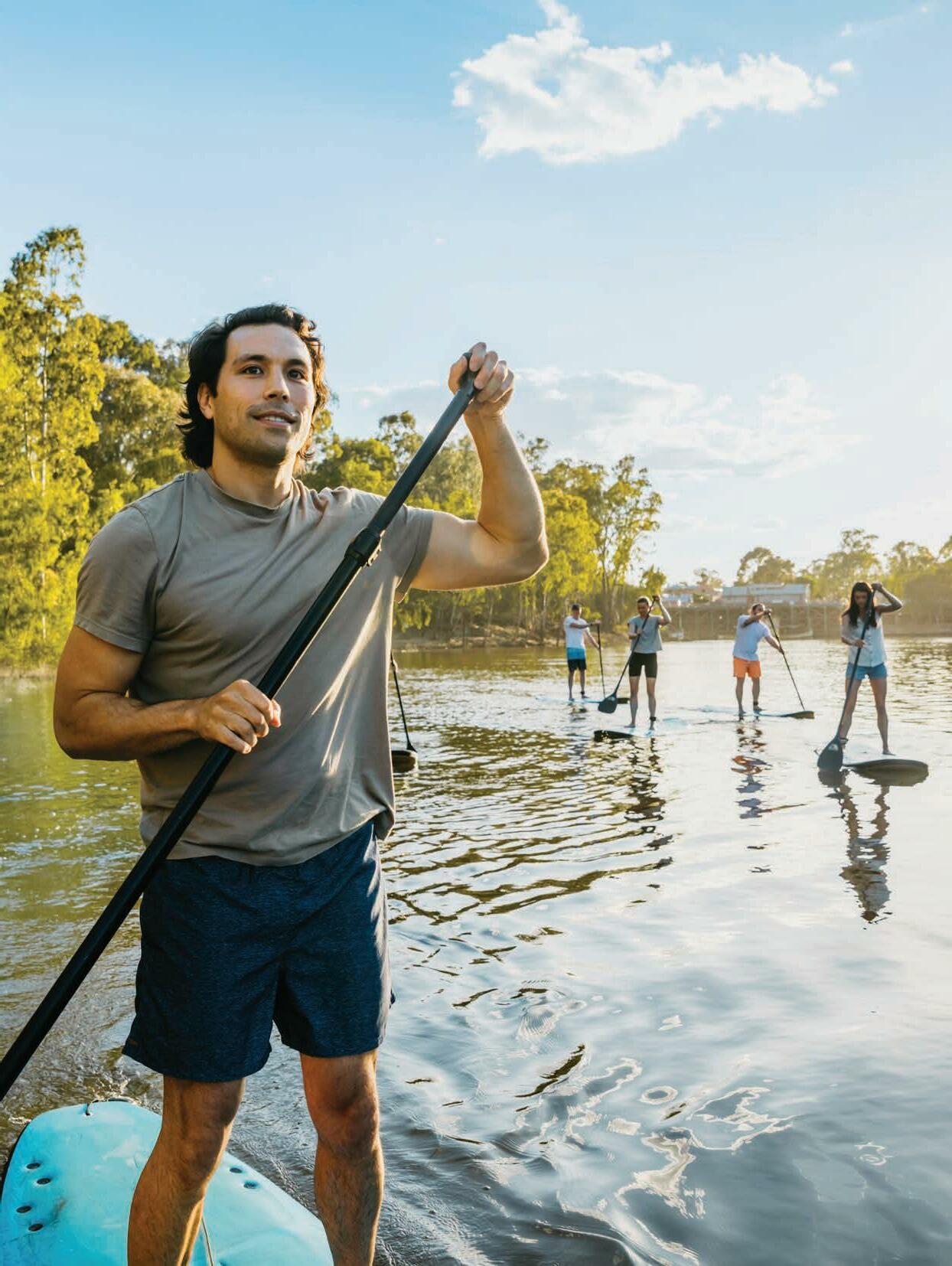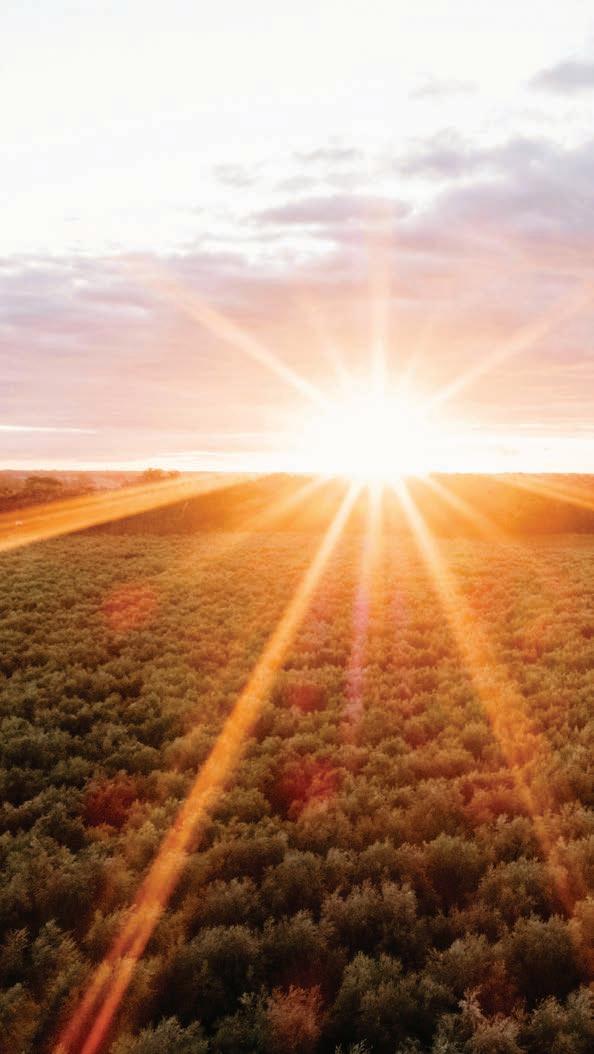
8 minute read
Chair’s Report
ANNUAL REPORT 2021 - 2022
www.visitthemurray.com.au www.murrayregionaltourism.com.au
CONTENTS
Chair’s Report
Board and Team
Visitor Economy Snapshot
Advocacy and Leadership Regional Marketing
Industry Development
Industry Education and Training
Destination Inspiration
Product Development
Governance & Sustainability
Financial Report
Financials 1
6
7
8
10
22
23
24
25
30
31
32
Acknowledgment of Country
We acknowledge the traditional custodians of the land and waters that surround the Murray River. We acknowledge and respect their history, culture and continuous connection to country. We pay our respects to elders – past, present and emerging who have cared for this country for over 60,000 years. This landscape, rich in story and opportunity, plays a pivotal part in our visitor economy and we thank Victoria and New South Wales First Peoples for sharing this with us all.

CHAIR’S REPORT
This has been a year of two distinct halves. As I stood before you online at the 2021 Annual General Meeting (AGM), we were in a period of lockdown, border closures, and uncertainty as to when the situation would change. Months on from that meeting we saw this uncertainty replaced with enthusiasm as businesses and regions welcomed back delighted visitors. It’s been a busy year.
During the height of the COVID-19 epidemic (2020-2022), the border between Victoria and NSW was closed several times for lengthy periods. This caused our border communities to become the most impacted communities in Australia, from a social and economic perspective

With these closures, the tourism industry and our Murray River community were brought to a standstill, struggling to understand the many rules and regulations that the cross-border communities had to juggle as we continued to navigate our way through the pandemic. During this difficult time we continued to collectively show great strength, resilience, and a clear sense of purpose.
With the end of lockdowns and severe restrictions in sight, it was time to cast our eyes toward 2022 and imagine what life in the “post-pandemic” world might look like.
2022 began with Murray Regional Tourism (MRT) as the driving force for supporting and growing the visitor economy across the Murray region, contemplating a path to economic recovery with tourism as a key driver for our region.
Our board and team worked hard with a clear ambition to continue improving outcomes via our strategic recovery plan. With five key pillars and a range of targeted objectives, we’ve been able to support our partners and industry to move forward and reactivate the visitor economy.
We were determined to do the best we could to help the region bounce back from the deepening crisis, committing significant time and resources toward protecting and assisting the community. Communication was at an all-time high with up to three industry newsletters being distributed per week, as regulations changed daily at times.
Advocacy and a strong voice for our region were paramount in every aspect of our combined efforts. The strength of the region’s visitor economy is a shared responsibility, and this time saw many government and industry stakeholders working together.
Preparedness for crisis management, resilience and workplace shifts will continue to be important.
We involved ourselves in a range of issues and concerns that were often outside our usual core focus in an endeavour to find solutions for our cross-border community.
The region’s recovery has been slower than anticipated, highlighting the economic damage of the pandemic that will be felt by our Murray River community for years to come.
For the year ending June 2022 the region welcomed 4.6 million visitors up 3.7% per cent on the previous year which had also been impacted with COVID-19. These visitors spent $1.6 billion in the Murray region which was up 31.3% cent on the previous year, which is a significant increase in expenditure. Further research results are available within this report, and full results are available on our corporate website.
CHAIR’S REPORT (cont)
Despite the challenges, we continued to deliver both a response and recovery program which has mitigated some of the impacts and will assist in establishing a strong foundation to continue to grow the visitor economy.
I would like to highlight some of the key initiatives over the year:
• Utilising Victorian State Government funding, we developed and delivered a successful “Destination
Marketing” recovery program, with a clear objective to: • Strengthen the appeal of the Murray as a short break destination amongst younger travellers in Winter, Spring, and Autumn • Rebuild confidence and broaden the appeal of the Murray • Increase consideration for key target audiences, especially in a strong competitor set of other Victorian destinations within a two-to-four hour drive from Melbourne.
• Delivered a successful Victorian State Government funded program called “Revitalising the Murray” – a strategic intervention consisting of five key deliverables to address the various aspects required to reactivate the visitor economy within the Murray region. This project delivered: • Murray River Cruising Strategy - This strategy will develop and enhance commercial river cruising experiences on the Murray River • Murray Region Consumer Research - A comprehensive research report to identify perceptions of the Murray region to inform both demand (marketing) and supply (product development) investment • Accommodation Diversification Gap Analysis – Research designed to build occupancy rates and assist recovery through alignment of the regional accommodation offering with consumer preferences • Murray Visitor Economy Dashboard - Development of a visitor economy digital research dashboard to monitor consumer insights to assist MRT, Local Governments, and operators to make informed strategic and commercial decisions • Murray Brand Digital Content Hub - Development of an online marketing content hub to provide centralised access to regional brand assets for the Murray region, along with sub-brand and co-branded content for our destinations and local government partners. • Further developed Murray River Road – an experience-led product – highlighting more than 2,500 kilometres of breathtaking scenery which make up the mighty
Murray region and the diverse range of key offerings and adventures along the river. This key strategic project aims to reposition the
Murray region to a younger audience and importantly increase the number of nights spent in the Murray region. • Delivered an expansive research program that has provided reports across a range of strategic areas and insights critical to our advocacy program to governments on behalf of the region • In collaboration with Destination Riverina Murray (DRM) and following on from the success of the 2021 events,
MRT delivered a highly engaging and effective Destination
Inspiration industry capacity-building program • Our team worked extensively with both Destination New South
Wales (DNSW) and Visit Victoria (VV) on securing and leveraging a range of marketing programs and opportunities for the Murray region

CHAIR’S REPORT (cont)
• Lodged several Victorian State Government funding applications to further develop the Murray River
Adventure Trail in collaboration with various government partners. Through this process MRT secured a really significant $10.3 million commitment toward implementation. • With the strong financial support from our two state government partners and MRT we are preparing a new Destination Management Plan (DMP), a blueprint for the future to drive more visitors to the Murray region and ensure continued sustainable growth of the visitor economy. • For the first time, with key funding from the Victorian State Government through Tourism, Events and the Visitor Economy (TEVE), the NSW
State Government through Destination Riverina Murray (DRM) and MRT, we are preparing 10 Local Area Action Plans (LAAPs). The LAAPs are strategic documents that will guide the destination focus over the next five years.
The LAAPs have been designed to directly respond to the needs and opportunities of the local visitor economy stakeholders in both the short and long term.
The aim of the LAAPs is to develop an action plan to be owned by local government and industry stakeholders, supported by MRT. It has been more important than ever to review and adapt our financial and governance systems so we continue to provide value and accountability to the region. With the current economic uncertainty, there is a need to contain our overheads and improve cash flow wherever possible. Mitigating risk is an exercise in protecting the organisation in the longer term as we learn to live in this “post-pandemic” future. MRT continues to benefit from our energetic, dedicated, and highly skilled board, and I sincerely thank them for their incredible work, commitment and passion which has guided us through the continued challenges of the past year. My deputy chair Greg Roberts, Natasha Callewaert, Natalie Ajay, John Dalton, Karina Ewer (Riverina and Murray Joint Organisation RAMJO) and Clare Keenan (Murray River Group of Councils MRGC) are all outstanding directors who work steadfastly and professionally to ensure our region shines. During this period there have been several changes to the board all due to changes in local government personnel which has meant that we have also needed to adjust their representation on our board. I would like to acknowledge those board members whom we have farewelled during this past year that include Kevin Mack (RAMJO), John McLinden (MRGC), Declan Moore (MRGC), and Cameron Sutton (skillsbased) all of whom contributed greatly to the organisation’s strategic outcomes. In line with our constitutional requirements, two board roles were advertised this year: one skills-based director to fulfill the vacancy left by Cameron Sutton, and the Chair position. In addition, two skills-based directors, Natasha Callewaert and John Dalton, completed their first terms with the board. Both were eligible to renominate and the board accepted their nominations. I am delighted that they both wish to continue to contribute with their key skill sets important to our organisation. I reapplied for the position of Chair, as felt that with the resignation of our Chief Executive Officer (CEO) and the current complex environment, it was important to have some stability. The board has endorsed my reappointment and I appreciate their confidence in me. I can assure everyone that I will continue to give the role my utmost as this region is just so critical to the tourism landscape.











